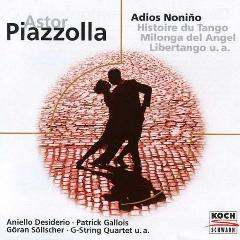Astor Piazzolla - Adios Nonino (2012)
Astor Piazzolla - Adios Nonino (2012)

01. Bordel 1900 03:45 02. Café 1930 06:52 03. Night-Club 1960 05:36 04. Concert d' aujourd'hui 02:54 05. Verano del '79 06:32 06. Tango apasionado 01:32 07. La Camorra II 06:35 08. Invierno porteno 04:23 09. Verano porteno 04:19 10. Oblivión 04:43 11. Libertango 05:39 12. Adios Noniño 08:10 13. Tango Nr. 2 05:19 14. Milonga del Angel 05:45 15. Michelangelo '70 02:57 Aniello Desiderio – guitar (1-4) Gennaro Desiderio – violin (1-4) Patrick Gallois – flute (13) Goran Sollscher – guitar (8,9,13) G-String Quarter (5-7, 14,15) Daniel Binelli – bandoneon Eduardo Isaac – guitar Louise Pellerin – oboe Orchestre Symphonique de Montreal Charles Dutoit – conductor (10) Hector Ulisses Pasarella – bandoneon Luis Enriquez Bacalov – piano Orchestra dell’Academia di Santa Cecilia Roma Myung-Whun Chung – conductor (11,12)
Astor Piazzolla was the head of the Tango Nuevo movement during the time that he was writing Adios Nonino in 1959. Piazzolla was entirely of Italian decent, with two very Italian parents. His daughter gave them traditional Italian names for grandma and grandpa, Nonino and Nonina. One of the things that Piazzolla was involved in during the time was the music direction of a dance team called the Juan Carlos Copes, who travelled to Puerto Rico in 1959. On the last night of their trip to San Juan, Piazzolla received a telegram saying his father had fallen off of his motorcycle and was in critical condition. Piazzolla discovered the next day that his father had died the next day at noon. One he was back home, he asked everyone to be left alone for a while. No one ever heard him cry, but his wife heard him sigh while writing a bright and happy tune. It was then that Astor Piazzolla’s Adios Nonino was born.
Adios Nonino became one of the most popular pieces that Piazzolla had ever written. He declared later that he was “Surrounded by angels”, and that “He probably could do not it again, this being the finest tune he’s ever written”. Piazzolla tweaked and redid his Adios Nonino and rewrote at least twenty more arrangements of the same tango. The song had no words, and Piazzolla intended to keep it that way. After the death of his father, he was inspired to go back to Argentina and write more authentic music with his American experiences. Lacking the money for the travel, he sent Adios Nonino to his publisher. His publisher was ecstatic, calling it the crown jewel of tangos. Piazzolla then made his way to Argentina. --- mangiaitalianothemusical.com








